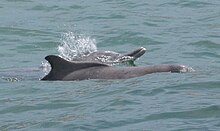
The Indo-Pacific humpback dolphin is a species of humpback dolphin inhabiting coastal waters of the eastern Indian and western Pacific Oceans. This species is often referred to as the Chinese white dolphin in mainland China, Macao, Hong Kong, Taiwan and Singapore as a common name. Some biologists regard the Indo-Pacific dolphin as a subspecies of the Indian Ocean humpback dolphin which ranges from East Africa to India. However, DNA testing studies have shown that the two are distinct species. A new species, the Australian humpback dolphin, was split off from S. chinensis and recognized as a distinct species in 2014. Nevertheless, there are still several unresolved issues in differentiation of the Indian Ocean-type and Indo-Pacific-type humpback dolphins.
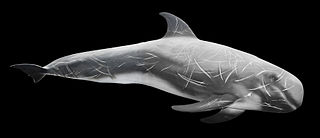
Risso's dolphin is a dolphin, the only species of the genus Grampus. Some of the closest related species to these dolphins include: pilot whales, pygmy killer whales, melon-headed whales, and false killer whales.

The white-beaked dolphin is a marine mammal belonging to the family Delphinidae in the suborder Odontoceti.

The pygmy right whale is a species of baleen whale. It may be a member of the cetotheres, a family of baleen whales which until 2012 were thought to be extinct; C. marginata has otherwise been considered the sole member of the family Neobalaenidae and is the only member of the genus Caperea. First described by John Edward Gray in 1846, it is the smallest of the baleen whales, ranging between 6 and 6.5 metres in length and 3,000 and 3,500 kilograms in mass. Despite its name, the pygmy right whale may have more in common with the gray whale and rorquals than the bowhead and right whales.

True's beaked whale is a medium-sized whale in the genus Mesoplodon. It is native to the northern Atlantic Ocean. The common name is in reference to Frederick W. True, a curator at the United States National Museum.

The long-finned pilot whale is a large species of oceanic dolphin. It shares the genus Globicephala with the short-finned pilot whale. Long-finned pilot whales are known as such because of their unusually long pectoral fins.

The Indo-Pacific bottlenose dolphin is a species of bottlenose dolphin. This dolphin grows to 2.6 m (8.5 ft) long, and weighs up to 230 kg (510 lb). It lives in the waters around India, northern Australia, South China, the Red Sea, and the eastern coast of Africa. Its back is dark grey and its belly is lighter grey or nearly white with grey spots.

The Atlantic humpback dolphin is a species of humpback dolphin that is found in coastal areas of West Africa.
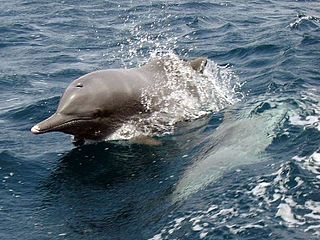
The Indian Ocean humpback dolphin is a member of the Delphinidae family occupying coastal areas ranging from Southern Africa to Western Indochina. The Indo-Pacific humpback dolphin was formerly included within the same species, but a 2014 study revealed them to be a separate species.

Fraser's dolphin or the Sarawak dolphin is a cetacean in the family Delphinidae found in deep waters in the Pacific Ocean and to a lesser extent in the Indian and Atlantic Oceans.

Peale's dolphin is a small dolphin found in the waters around Tierra del Fuego at the foot of South America. It is also commonly known as the black-chinned dolphin or even Peale's black-chinned dolphin. However, since Rice's work Peale's dolphin has been adopted as the standard common name.

The pantropical spotted dolphin is a species of dolphin found in all the world's temperate and tropical oceans. The species was beginning to come under threat due to the killing of millions of individuals in tuna purse seines. In the 1980s, the rise of "dolphin-friendly" tuna capture methods saved millions of the species in the eastern Pacific Ocean and it is now one of the most abundant dolphin species in the world.

The spinner dolphin is a small dolphin found in off-shore tropical waters around the world. It is famous for its acrobatic displays in which it rotates around its longitudinal axis as it leaps through the air. It is a member of the family Delphinidae of toothed whales.

The Clymene dolphin, in older texts known as the short-snouted spinner dolphin, is a dolphin endemic to the Atlantic Ocean. It is the only confirmed case of hybrid speciation in marine mammals, descending from the spinner dolphin and the striped dolphin.
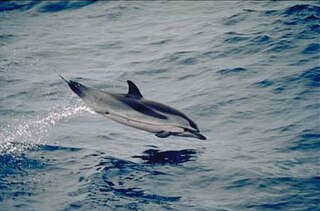
The striped dolphin is an extensively researched dolphin found in temperate and tropical waters of all the world's oceans. It is a member of the oceanic dolphin family, Delphinidae.
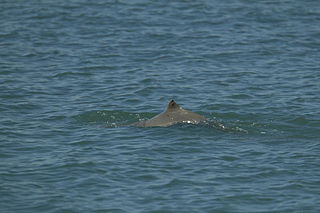
The Australian snubfin dolphin is a dolphin found off the northern coasts of Australia. It closely resembles the Irrawaddy dolphin and was not described as a separate species until 2005. The closest relative to the genus Orcaella is the killer whale, Orcinus orca. The Australian snubfin has three colors on its skin, while the Irrawaddy dolphin only has two. The skull and the fins also show minor differences between the two species.

The Memorandum of Understanding (MoU) for the Conservation of Cetaceans and their Habitats in the Pacific Island Region is a Multilateral Environmental Memorandum of Understanding concluded under the auspices of the Convention on Migratory Species of Wild Animals (CMS), also known as the Bonn Convention, and in collaboration with the Pacific Regional Environment Programme (SPREP). The MoU provides an international framework for coordinated conservation efforts to improve the conservation status of the Pacific Islands Cetaceans and came into effect on 15 September 2006.

The Memorandum of Understanding (MoU) Concerning the Conservation of the Manatee and Small Cetaceans of Western Africa and Macaronesia is a Multilateral Environmental Memorandum of Understanding and entered into effect on 3 October 2008 under the auspices of the Bonn Convention. The MoU covers 29 range States. As of August 2012, 17 range States have signed the MoU, as well as a number of cooperating organizations.

The Australian humpback dolphin is a species of humpback dolphin and the fourth recognized humpback dolphin species chronologically. The specific name sahulensis is derived from the Sahul Shelf, located between northern Australia and southern New Guinea, where the Australian humpback dolphins occur.
